Blog & Latest Updates
Fly Fishing Articles
Insects by Common Name


Insect Order Ephemeroptera (Mayflies)
Taxonomic Navigation -?-
Kingdom
Animalia (Animals)
» Phylum
Arthropoda (Arthropods)
» Class
Insecta (Insects)
» Order Ephemeroptera (Mayflies)
8 families aren't included.
Common Name
| Match | Common Name |
| Mayflies |
This is page 4 of specimens of Ephemeroptera. Visit the main Ephemeroptera page for:
- The behavior and habitat of Ephemeroptera.
- 67 underwater pictures of Ephemeroptera.
Pictures of 828 Mayfly Specimens:
Cinygmula subaequalis (Small Gordon Quill) Mayfly Nymph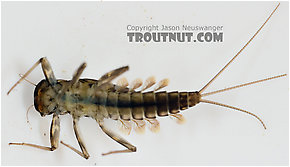 View 10 PicturesThis nymph is missing a few gills, but is otherwise in good shape. It was the only one of its species which turned up in my sample.
View 10 PicturesThis nymph is missing a few gills, but is otherwise in good shape. It was the only one of its species which turned up in my sample.
 View 10 PicturesThis nymph is missing a few gills, but is otherwise in good shape. It was the only one of its species which turned up in my sample.
View 10 PicturesThis nymph is missing a few gills, but is otherwise in good shape. It was the only one of its species which turned up in my sample.Collected May 29, 2007 from Paradise Creek in Pennsylvania
Added to Troutnut.com by Troutnut on June 4, 2007
Added to Troutnut.com by Troutnut on June 4, 2007
Hexagenia limbata (Hex) Mayfly Nymph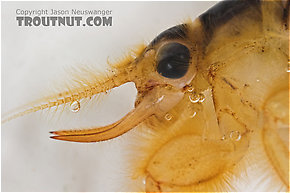 View 9 Pictures
View 9 Pictures
 View 9 Pictures
View 9 PicturesCollected June 8, 2005 from the Namekagon River in Wisconsin
Added to Troutnut.com by Troutnut on May 26, 2006
Added to Troutnut.com by Troutnut on May 26, 2006
Male Epeorus pleuralis (Quill Gordon) Mayfly Dun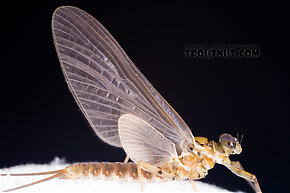 View 9 PicturesI kept this specimen after photographing it and it molted into a spinner in perfect condition, which I photographed here.
View 9 PicturesI kept this specimen after photographing it and it molted into a spinner in perfect condition, which I photographed here.
 View 9 PicturesI kept this specimen after photographing it and it molted into a spinner in perfect condition, which I photographed here.
View 9 PicturesI kept this specimen after photographing it and it molted into a spinner in perfect condition, which I photographed here.Collected April 30, 2007 from Dresserville Creek in New York
Added to Troutnut.com by Troutnut on May 3, 2007
Added to Troutnut.com by Troutnut on May 3, 2007
Male Eurylophella (Chocolate Duns) Mayfly Spinner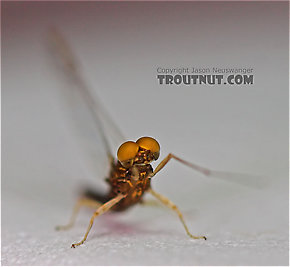 View 10 Pictures
View 10 Pictures
 View 10 Pictures
View 10 PicturesCollected June 4, 2005 from the Teal River in Wisconsin
Added to Troutnut.com by Troutnut on May 24, 2006
Added to Troutnut.com by Troutnut on May 24, 2006
Male Baetidae (Blue-Winged Olives) Mayfly Nymph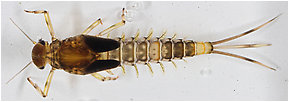 View 10 PicturesThis male nymph is probably in its final instar (Instar: Many invertebrates molt through dozens of progressively larger and better-developed stages as they grow. Each of these stages is known as an instar. Hard-bodied nymphs typically molt through more instars than soft-bodied larvae.). The wing pads (
View 10 PicturesThis male nymph is probably in its final instar (Instar: Many invertebrates molt through dozens of progressively larger and better-developed stages as they grow. Each of these stages is known as an instar. Hard-bodied nymphs typically molt through more instars than soft-bodied larvae.). The wing pads (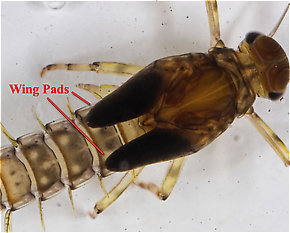 Wing pad: A protrusion from the thorax of an insect nymph which holds the developing wings. Black wing pads usually indicate that the nymph is nearly ready to emerge into an adult.) are extremely black and the large turbinate (
Wing pad: A protrusion from the thorax of an insect nymph which holds the developing wings. Black wing pads usually indicate that the nymph is nearly ready to emerge into an adult.) are extremely black and the large turbinate (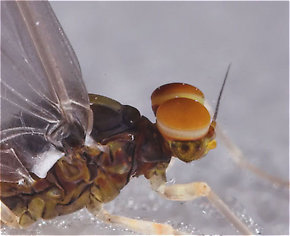 Turbinate: Shaped like a top or elevated on a stalk; usually refers to the eyes of some adult male Baetidae mayflies which are wider near the tip than at the base.) eyes are very apparent inside the nymph's head.
Turbinate: Shaped like a top or elevated on a stalk; usually refers to the eyes of some adult male Baetidae mayflies which are wider near the tip than at the base.) eyes are very apparent inside the nymph's head.
 View 10 PicturesThis male nymph is probably in its final instar (Instar: Many invertebrates molt through dozens of progressively larger and better-developed stages as they grow. Each of these stages is known as an instar. Hard-bodied nymphs typically molt through more instars than soft-bodied larvae.). The wing pads (
View 10 PicturesThis male nymph is probably in its final instar (Instar: Many invertebrates molt through dozens of progressively larger and better-developed stages as they grow. Each of these stages is known as an instar. Hard-bodied nymphs typically molt through more instars than soft-bodied larvae.). The wing pads (
The wing pads on this final instar Baetidae mayfly nymph are extremely dark.

This male Baetidae dun has slightly turbinate eyes.
Collected June 9, 2005 from the Bois Brule River in Wisconsin
Added to Troutnut.com by Troutnut on May 26, 2006
Added to Troutnut.com by Troutnut on May 26, 2006
Male Maccaffertium vicarium (March Brown) Mayfly Dun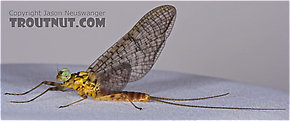 View 10 PicturesI collected this mayfly on the same trip as a female of the same species. After these photos it molted into a spinner. This is the form of Maccaffertium vicarium which anglers call the "Gray Fox."
View 10 PicturesI collected this mayfly on the same trip as a female of the same species. After these photos it molted into a spinner. This is the form of Maccaffertium vicarium which anglers call the "Gray Fox."
 View 10 PicturesI collected this mayfly on the same trip as a female of the same species. After these photos it molted into a spinner. This is the form of Maccaffertium vicarium which anglers call the "Gray Fox."
View 10 PicturesI collected this mayfly on the same trip as a female of the same species. After these photos it molted into a spinner. This is the form of Maccaffertium vicarium which anglers call the "Gray Fox."Collected May 28, 2005 from the Namekagon River in Wisconsin
Added to Troutnut.com by Troutnut on May 24, 2006
Added to Troutnut.com by Troutnut on May 24, 2006
Female Maccaffertium ithaca (Light Cahill) Mayfly Dun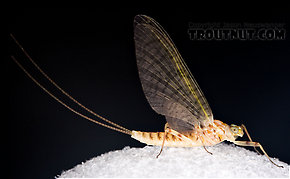 View 10 PicturesThis female looks very much like a male I collected a few hundred miles away a few days later, so I'm guessing it's the same species, which I believe is Maccaffertium mediopunctatum.
View 10 PicturesThis female looks very much like a male I collected a few hundred miles away a few days later, so I'm guessing it's the same species, which I believe is Maccaffertium mediopunctatum.
 View 10 PicturesThis female looks very much like a male I collected a few hundred miles away a few days later, so I'm guessing it's the same species, which I believe is Maccaffertium mediopunctatum.
View 10 PicturesThis female looks very much like a male I collected a few hundred miles away a few days later, so I'm guessing it's the same species, which I believe is Maccaffertium mediopunctatum.Collected May 23, 2007 from the Little Juniata River in Pennsylvania
Added to Troutnut.com by Troutnut on June 4, 2007
Added to Troutnut.com by Troutnut on June 4, 2007
Male Epeorus (Little Maryatts) Mayfly Spinner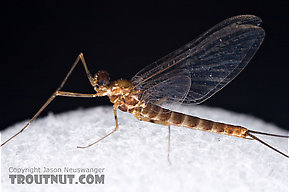 View 10 PicturesThis spinner and hundreds of others like it were dancing over the road through a very narrow valley carved by a tiny, steep tributary of the trout stream I was fishing. I got strange looks from a few passers-by, standing around on the road with a butterfly net...
View 10 PicturesThis spinner and hundreds of others like it were dancing over the road through a very narrow valley carved by a tiny, steep tributary of the trout stream I was fishing. I got strange looks from a few passers-by, standing around on the road with a butterfly net...
 View 10 PicturesThis spinner and hundreds of others like it were dancing over the road through a very narrow valley carved by a tiny, steep tributary of the trout stream I was fishing. I got strange looks from a few passers-by, standing around on the road with a butterfly net...
View 10 PicturesThis spinner and hundreds of others like it were dancing over the road through a very narrow valley carved by a tiny, steep tributary of the trout stream I was fishing. I got strange looks from a few passers-by, standing around on the road with a butterfly net...Collected May 9, 2007 from Unnamed trib of Factory Brook along 42a in New York
Added to Troutnut.com by Troutnut on May 18, 2007
Added to Troutnut.com by Troutnut on May 18, 2007
Drunella doddsii (Western Green Drake) Mayfly Nymph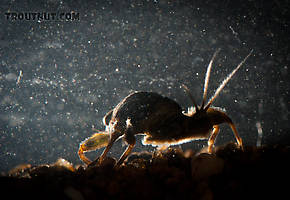 View 12 Pictures
View 12 Pictures
 View 12 Pictures
View 12 PicturesCollected July 17, 2011 from the Gulkana River in Alaska
Added to Troutnut.com by Troutnut on July 20, 2011
Added to Troutnut.com by Troutnut on July 20, 2011
Male Epeorus (Little Maryatts) Mayfly Dun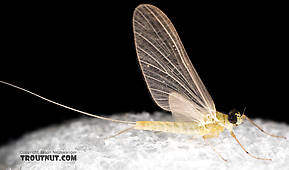 View 12 PicturesI hoped this dun would molt into a spinner for a positive ID, but it didn't. My best guess is Epeorus dulciana, but that's only because that's the smallest western Epeorus species, and this specimen is smaller than any of the others, with a body length of 5.3 mm (although it would be longer as a spinner) and a wing length of 8.5 mm.
View 12 PicturesI hoped this dun would molt into a spinner for a positive ID, but it didn't. My best guess is Epeorus dulciana, but that's only because that's the smallest western Epeorus species, and this specimen is smaller than any of the others, with a body length of 5.3 mm (although it would be longer as a spinner) and a wing length of 8.5 mm.
It was collected at the same time as a similar-sized female dun.
 View 12 PicturesI hoped this dun would molt into a spinner for a positive ID, but it didn't. My best guess is Epeorus dulciana, but that's only because that's the smallest western Epeorus species, and this specimen is smaller than any of the others, with a body length of 5.3 mm (although it would be longer as a spinner) and a wing length of 8.5 mm.
View 12 PicturesI hoped this dun would molt into a spinner for a positive ID, but it didn't. My best guess is Epeorus dulciana, but that's only because that's the smallest western Epeorus species, and this specimen is smaller than any of the others, with a body length of 5.3 mm (although it would be longer as a spinner) and a wing length of 8.5 mm.It was collected at the same time as a similar-sized female dun.
Collected July 5, 2017 from the South Fork Sauk River in Washington
Added to Troutnut.com by Troutnut on July 6, 2017
Added to Troutnut.com by Troutnut on July 6, 2017
Top 10 Fly Hatches
Top Gift Shop Designs
Eat mayflies.
Top Insect Specimens
Miscellaneous Sites
Troutnut.com is copyright © 2004-2024 Jason
Neuswanger (email Jason). See my FAQ for information about use of my images.
 privacy policy
privacy policy
